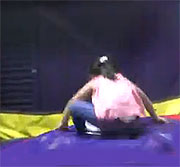
MONDAY, Nov. 26 (HealthDay News) — Inflatable bounce houses and moonwalks are springboards for childhood fun, but they’re also the source of an alarming number of children’s injuries, a new report warns.
On average, 31 children a day are transported to U.S. emergency departments for treatment of bounce-house injuries, including fractured bones and muscle damage, the study found.
“If this was an infectious disease, we’d call it an epidemic and it would be on the front pages all over the country,” said study co-author Dr. Gary A. Smith, director of the Center for Injury Research and Policy at Nationwide Children’s Hospital in Columbus, Ohio.
“Our message is that we want children to get up off the couch and be active, but we also like to inform parents of the risks of those activities,” Smith said.
As the popularity of inflatable bouncers has ballooned, so have reports of hurt children. Between 1995 and 2010, the rate of injuries jumped 15-fold, with the most rapid boost seen in the last few years of the study.
While public health officials have warned about the dangers of trampolines for years, they’ve paid little attention to these bouncers, which enable children to jump trampoline-style inside inflatable structures.
In the new study, published online Nov. 26 and in the December print issue of the journal Pediatrics, researchers studied emergency department records and estimated that almost 65,000 children were injured in inflatable bouncers from 1990 to 2010.
Patients were 7.5 years old on average, and the most common injuries were fractures (28 percent) and strains or sprains (27 percent), the investigators found. Concussions and cuts were more common among boys than girls, and 3 percent of the injured children required hospitalization or observation.
Injuries often followed falls — often a child falling on another youngster — or collisions, Smith said. In some cases, kids broke their forearms while trying to break their falls. Accidents occurred most often at sports or recreation sites (44 percent) or at someone’s home (38 percent).
Dr. Richard Schwend, chair of the American Academy of Pediatrics’ section on orthopedics and professor of orthopedics at University of Missouri-Kansas City School of Medicine, said that, in general, the injuries appeared to be minor.
“However, similar to trampolines, the potential for more severe injury is high when children are attempting stunts, or if a smaller child is being bounced by a larger child or children,” he said. “I have seen cervical spine injury and paralysis when a child jumps headfirst and lands on the head.”
If parents choose to let their kids play in bounce houses, they should make sure that they’re 6 years or older, Smith said. An adult should supervise the activity at all times and allow only one child inside at a time. If that’s not feasible, children should be of similar age and size, he pointed out.
Manufacturers, meanwhile, should look at ways to make the bounce houses safer, Smith added.
Dr. Tigran Avoian, an orthopedic surgeon at Los Angeles Orthopaedic Hospital who has studied the risks of bouncers, said they’re “fun to use and may be safe if used properly.”
However, “the importance of preventive measures to keep this attraction safe cannot be overestimated,” Avoian said.
“Because children are the end users and because companies typically do not provide the supervision on rented inflatable bouncers, the burden of safety falls ultimately on the parents’ shoulders,” Avoian noted. “Parents should be familiar with the risks and dangers and should receive proper supervision instruction.”
More information
The Royal Society for the Prevention of Accidents has details about bounce-house safety.

